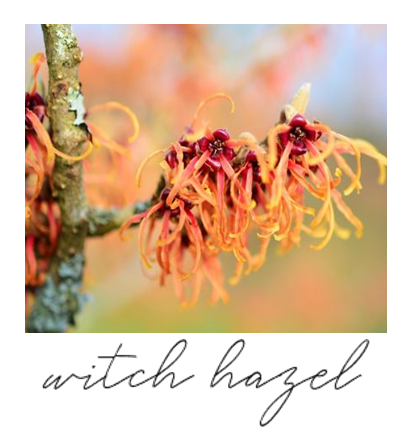
Download .pdf version
Columbia, SC--While most plants in South Carolina continue to hibernate until it is warm enough to make their spring debut, a few cold-tolerant, hardy species enter peak flowering during the early to mid-winter. Hamamelis virginiana, commonly known as American witch hazel, is one of these species. As a deciduous shrub native to the greater part of eastern North America, witch hazel is a great plant for all seasons.
Though a shrub, witch hazel can reach a height of up to 6 meters at maturity. The insect-pollinated flowers of the witch hazel bloom in clusters from November until January. Its simple, oval-shaped leaves are home to many types of insect galls, which are abnormal growths on leaves that serve as insect habitat. Coincidentally, a common gall found on witch hazel resembles a witch’s hat and is left behind by the Witch Hazel Leaf Roller Moth.
One may regard witch hazel as a botanical jack of all trades, with uses ranging from spiritual to medicinal. These uses may be connected to its puzzling name origin. Witch hazel is likely called “hazel” because early European settlers found a resemblance between the leaves of witch hazel and the hazel tree of Europe, but the provenance of “witch” is less clear.
Medicinally, witch hazel extract, derived from its branches, is used today to treat blemishes and insect bites, but historically was used to treat cancer, tumors, tuberculosis, and fevers. It has not been proven whether witch hazel “cures” any of these ailments, but its anti-inflammatory properties can help relieve skin conditions like acne. Some believe these medicinal and anti-inflammatory properties of witch hazel were interpreted as being “mystical” and “other-worldly” – adjectives associated with healers and witches.
Historically, the branches of witch hazel were used to dowse or “witch” for water. The branches are said to bend towards sources of underground freshwater. While never scientifically proven, this method of water-finding has been used for centuries across cultures and may be connected to the plant’s name.
Alternately, “witch” may be a derivation from the Old English word “wych,” meaning “bendy,” which may describe the pliable and tangled branches of the witch hazel or the belief that it bends towards water. Although the exact origin of its name is uncertain, it is known that witch hazel has served a wide variety of purposes for centuries in North America.
Witch hazel’s year-round utility makes it the perfect addition to anyone’s garden. Witch hazel’s winter blooms provide pollinators with a source of food and habitat between the warmer seasons. To get a robust bloom, the witch hazel needs a great deal of sun exposure, but not so much that it burns in the warmer seasons. It prefers a soil that is deep, lightly acidic, moist, and rich in organic matter. Ideal locations may be along a forest line or a stream. Witch hazel requires very little maintenance once established, as it does not tend to suffer from insect infestations or disease.
To spruce up your landscaping and help protect pollinators during the colder seasons, look no further than the American witch hazel!
References: U.S. Forest Service, Brooklyn Botanical Garden, University of Kentucky, Virginia Native Plant Society
Download .pdf version
# # #
Conservation Districts are political subdivisions of state government under the local direction of five-member Boards of Commissioners. In South Carolina, Conservation District boundaries conform to County boundaries. The Richland Soil and Water Conservation District promotes the wise use and care of natural resources for long-term sustainability.
Contact
Richland Soil and Water Conservation District
2020 Hampton Street, Room 3063A
Columbia, SC 29204
Phone (803) 576-2080
Fax (803) 576-2088
E-mail soilandwater@rcgov.us
Facebook www.facebook.com/rswcd